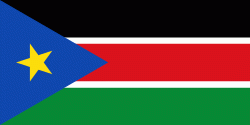Maban County (Maban County)
Greater Maban (which means the people of the land) is a county located in the Upper Nile State of South Sudan. The county capital is the town of Bunj. In 2017, the South Sudan government divided the county into two: North East and South West.
Four rivers flow through the Greater Maban County: the Ahmar, the Yale, the Tombak, and the Yabus. In September 2012, heavy rains and flooding were experienced in the Tombak floodplain.
There are four refugee camps in the Greater Maban region where 142,500 refugees reside. They are largely occupied by people fleeing armed conflict in Sudan's Blue Nile and South Kordofan states. The largest camps are, from west to east: Kaya (formerly Jamam; moved due to flooding), Yosuf Batil (known locally as Batil), Gendrassa (directly abutting Batil), and Doro (near the town of Bunj). The camps were initially supported by the World Food Programme, through food air drops, but since 2013 the UN Refugee Agency: UNHCR in partnership with NGOs are providing more stable relief services.
In September 2012, a Hepatitis E outbreak was reported in the camps. As of June 2018, the camps hold an estimated 142,500 refugees.
Four rivers flow through the Greater Maban County: the Ahmar, the Yale, the Tombak, and the Yabus. In September 2012, heavy rains and flooding were experienced in the Tombak floodplain.
There are four refugee camps in the Greater Maban region where 142,500 refugees reside. They are largely occupied by people fleeing armed conflict in Sudan's Blue Nile and South Kordofan states. The largest camps are, from west to east: Kaya (formerly Jamam; moved due to flooding), Yosuf Batil (known locally as Batil), Gendrassa (directly abutting Batil), and Doro (near the town of Bunj). The camps were initially supported by the World Food Programme, through food air drops, but since 2013 the UN Refugee Agency: UNHCR in partnership with NGOs are providing more stable relief services.
In September 2012, a Hepatitis E outbreak was reported in the camps. As of June 2018, the camps hold an estimated 142,500 refugees.
Map - Maban County (Maban County)
Map
Country - South_Sudan
 |
 |
| Flag of South Sudan | |
South Sudan gained independence from Sudan on 9 July 2011, making it the most recent sovereign state or country with widespread recognition as of 2023. It includes the vast swamp region of the Sudd, formed by the White Nile and known locally as the Bahr al Jabal, meaning "Mountain River". Sudan was occupied by Egypt under the Muhammad Ali dynasty and was governed as an Anglo-Egyptian condominium until Sudanese independence in 1956. Following the First Sudanese Civil War, the Southern Sudan Autonomous Region was formed in 1972 and lasted until 1983. A second Sudanese civil war soon broke out in 1983 and ended in 2005 with the Comprehensive Peace Agreement. Later that year, southern autonomy was restored when an Autonomous Government of Southern Sudan was formed. South Sudan became an independent state on 9 July 2011, following 98.83% support for independence in a January 2011 referendum. It has suffered ethnic violence and endured a civil war characterized by rampant human rights abuses, including various ethnic massacres and killings of journalists by various parties to the conflict from December 2013 until February 2020, when competing combat leaders Salva Kiir Mayardit and Riek Machar struck a unity deal and formed a coalition government, paving the way for refugees to return home.
Currency / Language
| ISO | Currency | Symbol | Significant figures |
|---|---|---|---|
| SSP | South Sudanese pound | £ | 2 |
| ISO | Language |
|---|---|
| EN | English language |















